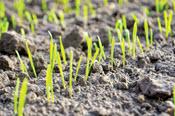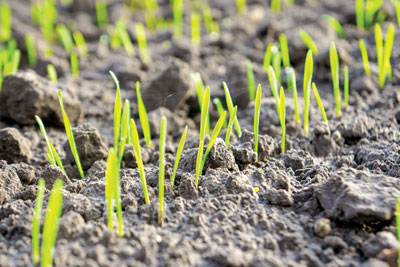
Application Is Still Effective Despite Price Hikes – With Some Conditions.
By Stacy Berry
Phosphorus is “one of the three macronutrients required by plants in the greatest quantities (nitrogen and potassium are the other two),” explains Stacie Yaremko, manager of Agronomic Solutions with Nutrien Ag Solutions in Peace River, Alta.
The term macronutrient simply means that lots of it is needed. “You need phos in pounds per bushel, not grams,” further explains Kelsey Klyzub, sales leader with Cargill, based in Vermilion, Alta.
Why does a plant need phosphorus?
Karl Wyant, director of Agronomy with Nutrien in Phoenix, Ariz., says that “phosphorus holds up your genes. If DNA is a ladder, phosphorus is the sides holding up the rungs. It’s the currency your cells use – ATP (adenosine triphosphate) is like money exchanged between cells. Even cell membranes need phosphorus – all organelles are enclosed with a phospholipid bilayer.”
“Deficiency can look different,” says Yaremko, “but a few key things to look for: Slow growth or establishment, purpling and/or stunting of plants, especially on the oldest growth, and delayed maturity.”
Phosphorus availability is an issue in many places.
Wyant studied desert science in the U.S. in a variety of crops and sees similar problems regularly. “Phosphorus is very friendly,” jokes Wyant. “Phosphate is a strongly negative ion, and it attracts positive ions. It hugs them real tight, making phosphorus unavailable to the plant, and that can also drive other nutrient deficiencies.”
Because of its friendliness, “phosphorus is inefficient,” says Wyant. “When you apply phosphorus, only five to 30 per cent of an application gets into a plant that year. There are losses you can’t see – chemical reactions tying up phosphorus in the soil. In acidic soils, that’s with iron and aluminum. In alkaline soils, that’s calcium – and losses you can see, like erosion. How you apply P is crucial to prevent losses.”
Klyzub agrees with this sentiment. “Application? That’s my favourite question and probably the biggest concern with phosphate. It’s immobile in the soil, so seed placing your phosphate is important. Please, don’t put your phosphorus in a mid-row bander. By the time the plant can reach it with its roots, the largest requirement has passed.”
Yaremko further explains that “root uptake is the optimal way for plants to obtain phosphorus; very little is absorbed through foliar applications. Phosphorus also moves via diffusion, so banding creates a diffusion gradient that can drive phosphorus into the plant root. Phosphorus fertilizer should be placed in a concentrated band, either near or in the seed row.”

Both Yaremko and Klyzub warn farmers: Too much seed-placed phosphorus can effectively “burn the newly emerging roots.” This is mitigated through soil sampling, maintaining field nutrient levels, and applying smart.
Besides being the most agronomically sound placement, “banding P fertilizer below the soil surface also reduces the chance that the fertilizer will move off of the field (through erosion or runoff), thereby reducing environmental risk as well,” Yaremko adds.
Most producers have noticed the hike in phosphorus prices recently.
Phosphorus is used for more than just soil amendments; it’s also the basis of several popular pesticides.
Yaremko explains. “As was the trend with most things in the past year, supply chain issues and market disruption due to war and general global uncertainty led to sharp price increases. Phosphorus fertilizer is derived from rock phosphate, located in a few key areas globally, namely in Morocco, China, South Africa, and the United States.”
“Transportation and production costs are a big part of our prices here in Canada,” adds Klyzub.
Wyant: “Demand for phosphorus continues to rise. Phosphorus is not just used in agriculture – it’s used in food ingredients, carbonated soft drinks, industry, and more. There is a tightening of supply – countries are not exporting as much because they need to satisfy their own needs.”
Because of this, “normally, we would see the price softening by now, and it’s just not doing that this year,” says Klyzub.
Phosphorus is clearly vital to crop production, however, at some point is it not worth it anymore?
Dillon Mulak, a farmer in Waskatenau, Alta., says yes, application is worth it despite the price hikes – with some qualification.
Mulak knows the importance of adaptability in farming. “As long as commodity prices match the increase in input prices, I'm very comfortable continuing to apply phosphorus. If not, then less phosphorus-intensive crops could be put into rotation, or simply reducing application, as the market would be signalling us to ease back.”
So, how can you get your phosphorus needs met without breaking the bank?
It’s not lost on Klyzub that the farmers are the ones taking the risk and putting money out there.
Klyzub stresses that, when done well, “your fertilizer will get you crop.” However, there may be another solution to consider. “Everyone is looking to get rid of manure. There are also lots of other micronutrients, organic matter, and plenty of macronutrients (like potassium and nitrogen) in it.”
Yaremko agrees. “If producers have access to manure or compost, this is an excellent source of phosphorus. Manure application does, however, require some specialized equipment, so it may not be an option for many operations.”
Often the price of transporting manure is a limiting factor.
Mulak “would love to use it more. We currently use some manure in our nutrient management plan, but the acres require more than what is produced by our cattle currently.”
Wyant concurs. “You have to live close to the source, or the transport costs are just too high.”
A strong recommendation is soil testing, so you apply what you need. This is both economical and environmentally sound.
“Phosphate is applied separately and variably from field to field on our farm,” says Mulak. “We base our phosphate application rate at either a ‘build’ or ‘maintenance’ rate depending on the crop and yield goals as well as the soil tests.”
This allows Mulak a little wiggle room when prices fluctuate. Mulak also tries to market grain around the same time as fertilizer is purchased “to eliminate risk from input and output prices disassociating.”
Klyzub reminds farmers that “phosphorus is a bank you need to keep full. The people consistently applying phosphate are the ones that see better and consistent yields, even in the most trying times.”
Regular soil testing helps a farmer monitor their levels and adjust as needed.
Yaremko notes that “it is easier to maintain healthy phosphorus levels than to build up soils that have already become deficient. Conversely, building soil phosphorus into the excessive range poses an environmental risk and should be avoided as well.”
What about the future of phosphorus? The level of concern varies.
Yaremko: “Phosphorus is a non-renewable resource. Many areas rich in phosphorus rock are frequently subject to political unrest, which threatens global access to supply. Refining phosphate rock into fertilizer takes a considerable amount of energy and resources, a growing concern in light of climate change.
“We have limited capability to recapture phosphorus as it makes its way through the food chain. This is obviously a huge issue because a finite resource is being permanently lost from the food production system, but it also causes massive ecological problems like eutrophication.”
All hope is not lost, however. Klyzub explains that “we have been able to go back to old mines using new technology and access phosphates we couldn’t before. And yes, there is so much phosphorus waste – through food, animals, people, the waterways. However, that means there are lots of areas we can fix, and we will see tons of new technology and ideas.”
Wyant has been involved in many phosphorus conservation conversations over the years. “Fertilizer is only one piece of the chain. Farmers are looking at soil tests, applying smart, picking up new information and running with it. Conversations are changing for the better.”
Mulak is also hopeful for new technology. “Between products on the market that recycle phosphorus from effluent, to our access to biological products allowing us unlock unavailable soil phosphorus – I'm confident we will be able to manage our phosphorus for the foreseeable future.”
Producers looking for more information have a few options.
Yaremko: “Working with a trusted agronomist, whether that be a supplier or third party, is a great first step. That person will likely recommend soil testing. The agronomist will then work with the producer to develop a nutrient management plan.”

Wyant recommends farmers check out podcasts and agronomy articles. “The community that you build around you – there is always someone out there doing something different. Keep on top of new developments and ideas.”
Mulak also recommends searching online. “Everyone from Bourgault to the Canola Council to papers published by agricultural universities has interesting and relevant information.
“After that I would start conversations with neighbours who share your interest in fertility. I've found that most people are more than happy to share their experiences.
“After that, check the local retail or private agronomists regarding their experiences in the area. I'm a big believer in local knowledge and experience, as some information you collect online could be from far away.” BF



Post new comment